ECU CHEVROLET CAMARO 1967 1.G Chassis Workshop Manual
[x] Cancel search | Manufacturer: CHEVROLET, Model Year: 1967, Model line: CAMARO, Model: CHEVROLET CAMARO 1967 1.GPages: 659, PDF Size: 114.24 MB
Page 9 of 659
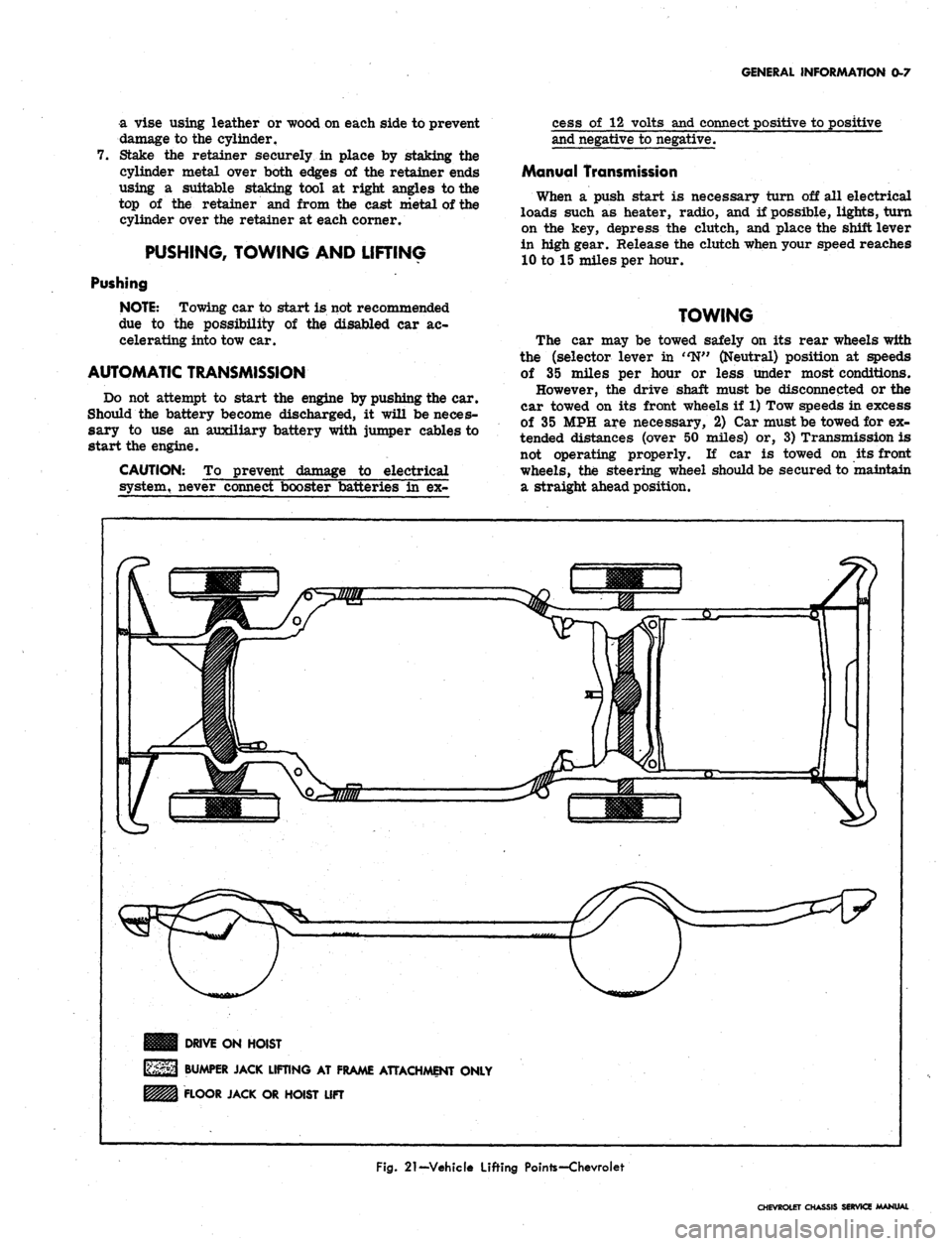
GENERAL INFORMATION 0-7
a vise using leather or wood on each side to prevent
damage to the cylinder,
7. Stake the retainer securely in place by staking the
cylinder metal over both edges of the retainer ends
using a suitable staking tool at right angles to the
top of the retainer and from the cast metal of the
cylinder over the retainer at each corner.
PUSHING, TOWING AND LIFTING
Pushing
NOTE:
Towing car to start is not recommended
due to the possibility of the disabled car ac-
celerating into tow car.
AUTOMATIC TRANSMISSION
Do not attempt to start the engine by pushing the car.
Should the battery become discharged, it will be neces-
sary to use an auxiliary battery with jumper cables to
start the engine.
CAUTION: To prevent damage to electrical
system, never connect booster batteries in ex-
cess of 12 volts and connect positive to positive
and negative to negative.
Manual Transmission
When a push start is necessary turn off all electrical
loads such as heater, radio, and if possible, lights, turn
on the key, depress the clutch, and place the shift lever
in high gear. Release the clutch when your speed reaches
10 to 15 miles per hour.
TOWING
The car may be towed safely on its rear wheels with
the (selector lever in "N" (Neutral) position at speeds
of 35 miles per hour or less under most conditions.
However, the drive shaft must be disconnected or the
car towed on its front wheels if 1) Tow speeds in excess
of 35 MPH are necessary, 2) Car must be towed for ex-
tended distances (over 50 miles) or, 3) Transmission is
not operating properly. If car is towed on its front
wheels, the steering wheel should be secured to maintain
a straight ahead position.
DRIVE ON HOIST
BUMPER JACK LIFTING AT FRAME ATTACHMENT ONLY
FLOOR JACK OR HOIST LIFT
Fig.
21-Vehicle Lifting Pointe-Chevroiet
CHEVROLET CHASSIS SERVICE MANUAL
Page 66 of 659
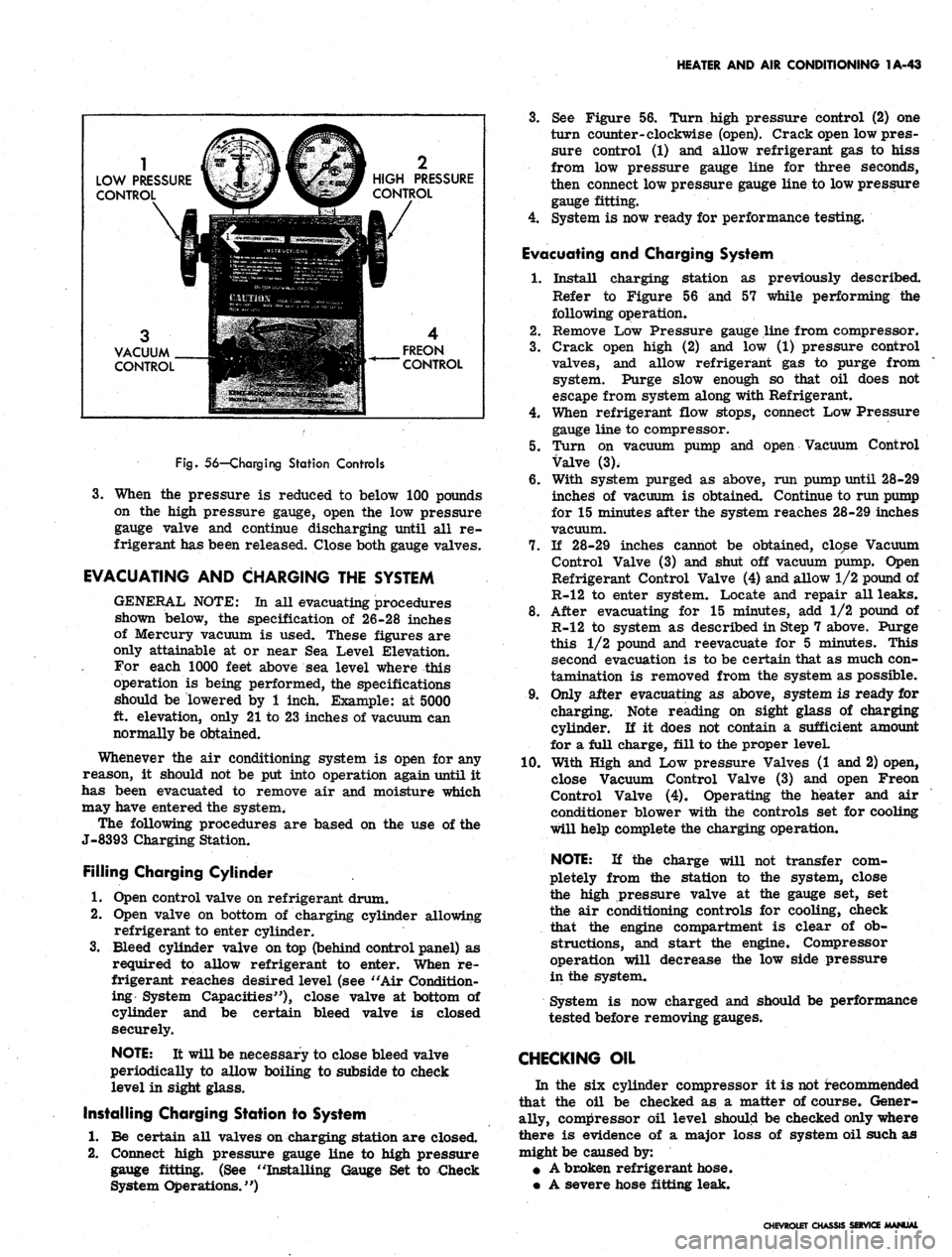
HEATER AND AIR CONDITIONING 1A-43
LOW PRESSURE
CONTROL
HIGH PRESSURE
CONTROL
3
VACUUM
CONTROL
4
FREON
CONTROL
Fig,
56—Charging Station Controls
3.
When the pressure is reduced to below 100 pounds
on the high pressure gauge, open the low pressure
gauge valve and continue discharging until all re-
frigerant has been released. Close both gauge valves.
EVACUATING AND CHARGING THE SYSTEM
GENERAL NOTE: La all evacuating procedures
shown below, the specification of 26-28 inches
of Mercury vacuum is used. These figures are
only attainable at or near Sea Level Elevation.
For each 1000 feet above sea level where this
operation is being performed, the specifications
should be lowered by 1 inch. Example: at 5000
ft. elevation, only 21 to 23 inches of vacuum can
normally be obtained.
Whenever the air conditioning system is open for any
reason, it should not be put into operation again until it
has been evacuated to remove air and moisture which
may have entered the system.
The following procedures are based on the use of the
J-8393 Charging Station.
Filling Charging Cylinder
1.
Open control valve on refrigerant drum.
2.
Open valve on bottom of charging cylinder allowing
refrigerant to enter cylinder.
3.
Bleed cylinder valve on top (behind control panel) as
required to allow refrigerant to enter. When re-
frigerant reaches desired level (see "Air Condition-
ing System Capacities"), close valve at bottom of
cylinder and be certain bleed valve is closed
securely.
NOTE: It will be necessary to close bleed valve
periodically to allow boiling to subside to check
level in sight glass.
Installing Charging Station to System
1.
Be certain all valves on charging station are closed.
2.
Connect high pressure gauge line to high pressure
gauge fitting. (See "Installing Gauge Set to Check
System Operations.")
3.
See Figure 56. Turn high pressure control (2) one
turn counter-clockwise (open). Crack open low pres-
sure control (1) and allow refrigerant gas to hiss
from low pressure gauge line for three seconds,
then connect low pressure gauge line to low pressure
gauge fitting.
4.
System is now ready for performance testing.
Evacuating and Charging System
1.
Install charging station as previously described.
Refer to Figure 56 and 57 while performing the
following operation.
2.
Remove Low Pressure gauge line from compressor.
3.
Crack open high (2) and low (1) pressure control
valves, and allow refrigerant gas to purge from
system. Purge slow enough so that oil does not
escape from system along with Refrigerant.
4.
When refrigerant flow stops, connect Low Pressure
gauge line to compressor.
5.
Turn on vacuum pump and open Vacuum Control
Valve (3).
6. With system purged as above, run pump until 28-29
inched of vacuum is obtained. Continue to run pump
for 15 minutes after the system reaches 28-29 inches
vacuum.
7.
If 28-29 inches cannot be obtained, close Vacuum
Control Valve (3) and shut off vacuum pump. Open
Refrigerant Control Valve (4) and allow 1/2 pound of
R-12 to enter system. Locate and repair all leaks.
8. After evacuating for 15 minutes, add 1/2 pound of
R-12 to system as described in Step 7 above. Purge
this 1/2 pound and reevacuate for 5 minutes. This
second evacuation is to be certain that as much con-
tamination is removed from the system as possible.
9. Only after evacuating as above, system is ready for
charging. Note reading on sight glass of charging
cylinder. If it does not contain a sufficient amount
for a full charge, fill to the proper leveL
10.
With High and Low pressure Valves (1 and 2) open,
close Vacuum Control Valve (3) and open Freon
Control Valve (4). Operating the heater and air
conditioner blower with the controls set for cooling
will help complete the charging operation.
NOTE: If the charge will not transfer com-
pletely from the station to the system, close
the high pressure valve at the gauge set, set
the air conditioning controls for cooling, check
that the engine compartment is clear of ob-
structions, and start the engine. Compressor
operation will decrease the low side pressure
in the system.
System is now charged and should be performance
tested before removing gauges.
CHECKING OIL
In the six cylinder compressor it is not recommended
that the oil be checked as a matter of course. Gener-
ally, compressor oil level should be checked only where
there is evidence of a major loss of system oil such as
might be caused by:
• A broken refrigerant hose.
• A severe hose fitting leak.
CHEVROLET CHASSIS SERVICE MANUAL
Page 122 of 659

CORVETTE BODY 1B-15
Fig.
32—Removing Regulator
GLASS RUN CHANNEL-REAR
Removal
For parts identification refer to Figure 41.
1.
Remove door trim assembly as outlined in this
section.
2.
Remove window glass assembly as outlined in this
section.
3.
Remove 2 channel retaining screws and pass chan-
nels out through large opening in door inner panel
(fig. 42).
Fig.
33—Removing Ventilator Assembly 19437
Installation
1.
Position run channel in door and install bolts loosely.
2.
Install window glass as outlined in this section.
3.
Make necessary adjustments to channel as outlined
under Doors - Adjustments - Door Windows.
4.
Replace door window and door trim panel.
WINDOW REGULATOR-MANUAL
For parts identification see Figure 41.
Removal
1.
Remove trim panel as outlined in this section.
2.
Remove door window glass as outlined in this
section.
3.
Remove screws retaining regulator assembly to
door panel.
4.
Remove screws holding lower guide rail to door
panel.
5. Remove regulator assembly from large access open-
ing as shown in Figure 43.
Installation
Regulator may be installed by following removal pro-
cedure in reverse order. Always lubricate all guide rails
and rollers when regulator is disassembled. Test regula-
tor thoroughly before installing door trim panel. Adjust
window as outlined in this section.
WINDOW REGULATOR-POWER
In cases where window will not operate, check electri-
cal connections first. Figure 44 illustrates lpcation of
junctions, switches and circuit breaker.
Removal
Perform operations 1 thru 5 under Window Regulator-
Manual Removal. Note, however, that electrical connec-
tors must be removed from motor before performing
any operation on regulator. Figure 44 illustrates in-
stallation of regulator on door and regulator wiring.
Disassembly
NOTE:
Do not attempt to remove motor from
regulator until the following operations are per-
formed. THIS IS A SAFETY ITEM; arm is
spring-loaded and may cause injury if not locked
in position when motor is removed.
Refer to Figure 45.
1.
Place regulator assembly in vise.
2.
Using jumper leads to 12 volt power supply, operate
motor until semi-circular hole in sector gear cen-
ters over one of two weld nuts on mounting plate.
3.
Screw a l/4"-20 x 1" bolt into weld nut so that end
passes through hole in sector gear. It may be neces-
sary to enlarge hole in gear slightly with file or
drill. Install nut on bolt to lock arm in position.
Installation
1.
Be sure lock bolt has been removed if regulator
has been disassembled.
2.
Install lubricated regulator assembly and guide rails
in door in reverse order of removal.
3.
Install window as outlined in this section.
4.
Making sure connectors are securely installed on
motor, test operation of window thoroughly.
5. Install door trim panel and handles as outlined in
this section.
CHEVROLET CHASSIS SERVICE MANUAL
Page 126 of 659

CORVETTE BODY 1B-T9
Fig.
43—Removing Regulator Assembly
REAR QUARTER
DOOR SILL PLATE AND MOLDING
Figure 49 shows assembly details of both the door sill
plate and molding. The sill plate which retains the car-*
pet, the cowl trim windlace and lock pillar front edge
trim are retained to the body by six screws.
The molding assembly, which replaces a rocker panel,
is quickly and easily replaced by removing 10 retaining
screws. The sill molding retainer is also fastened to the
body with screws.
REAR END
FOLDING TOP COMPARTMENT LID
Adjustments
Hinges
The folding top compartment lid should be adjusted so
that in the closed position the surface of the lid is flush
with surrounding body surfaces and space between lid
edge and body is 1/16" to 3/16" at sides and 3/16" to
1/4" at rear. Whenever lid position is changed on hinges,
lock engagement must be inspected and adjusted if neces-
sary. Adjust hinge position as follows:
1.
Scribe a line on lid surface following contour of hinge
strap.
This will ease observation of lid movement
during adjustment (fig. 51).
2.
To raise or lower top surface of lid, add or remove
hinge shims.
3.
To adjust spacing between lid edges and body, loosen
hinge-to-lid screws and shift lid as required.
Lock
Lock engagement may be adjusted as follows:
1.
Striker plates may be shimmed to adjust the depth
of lock engagement in striker plate. When this ad-
justment is made, release of lock should be tested
and adjusted as required.
2.
Release of lock may be adjusted by loosening lock
assembly retaining bolts and moving lock in ap-
propriate direction to the limit of slotted holes in
, lock base. Further adjustment may be gained by
moving cable retainer in appropriate direction.
Hinges
(Refer to Figure 52)
Removal
1.
Scribe around hinge as shown in Figure 51.
2.
Hinge may be removed as an assembly by opening
top compartment lid fully and removing 3 retaining
screws. Note number of shims found between hinge
frame and compartment floor.
3.
To remove spring from hinge assembly, close top
compartment lid as far as possible and insert Tool
J-9559 between expanded coils in spring. Opening
top compartment lid fully will allow removal of
spring as shown in Figure 53.
4.
As soon as spring is removed, insert long bolt sup-
plied with J-9559 through holes in end of tool, pass-
ing it through spring, and install nut on bolt.
Spring may be removed from J-9559 or J-9559 may be
installed in a new spring, by the following method:
1.
Place a closed 6 or 8 inch "C" clamp in a vise or
fasten it to a heavy bench top (bench should be fas-
tened to floor).
2.
Hook one end of spring in clamp and the other end
in hook of chain hoist, "cherrypicker" or equivalent,
as shown in Figure 54.
3.
Stretch the spring enough to allow insertion of
J-9559. Install through bolt if spring is not to be in-
stalled on hinge at once.
installation
1.
Install same number of shims as removed or, if
repairing collision damage, etc., position hinge in
compartment, install upper mounting screws, fill
gap between floor and hinge frame with shims and
install lower mounting screw.
2.
If spring has been removed from hinge, install
spring in J-9559 and place spring on hinge with com-
partment lid raised; closing lid releases J-9559 for
removal. Upper end of spring should rest in one of
three notches yielding best lid operation. About 3
pounds pressure should be necessary to close lid.
Lock
Removal
1.
Remove cable mounting clamps. Remove retainer
from control cable assembly and disengage cable
from control.
2.
Scribe a mark on lid following outer contour of lock
assembly.
3.
Remove 3 lock assembly retaining screws and re-
move lock from compartment lid.
Installation
1.
Place lock assembly on compartment lid within
scribed line and install retaining screws.
2.
Install end of cable in control assembly and fasten
retainer securely.
3.
Test operation of lock thoroughly, adjusting if neces-
sary as outlined in this section.
Control
Removal
1.
Remove inner mounting clamps from both cables
and disengage cables from control by removing
retainers.
CHEVROLET CHASSIS SERVICE MANUAL
Page 127 of 659
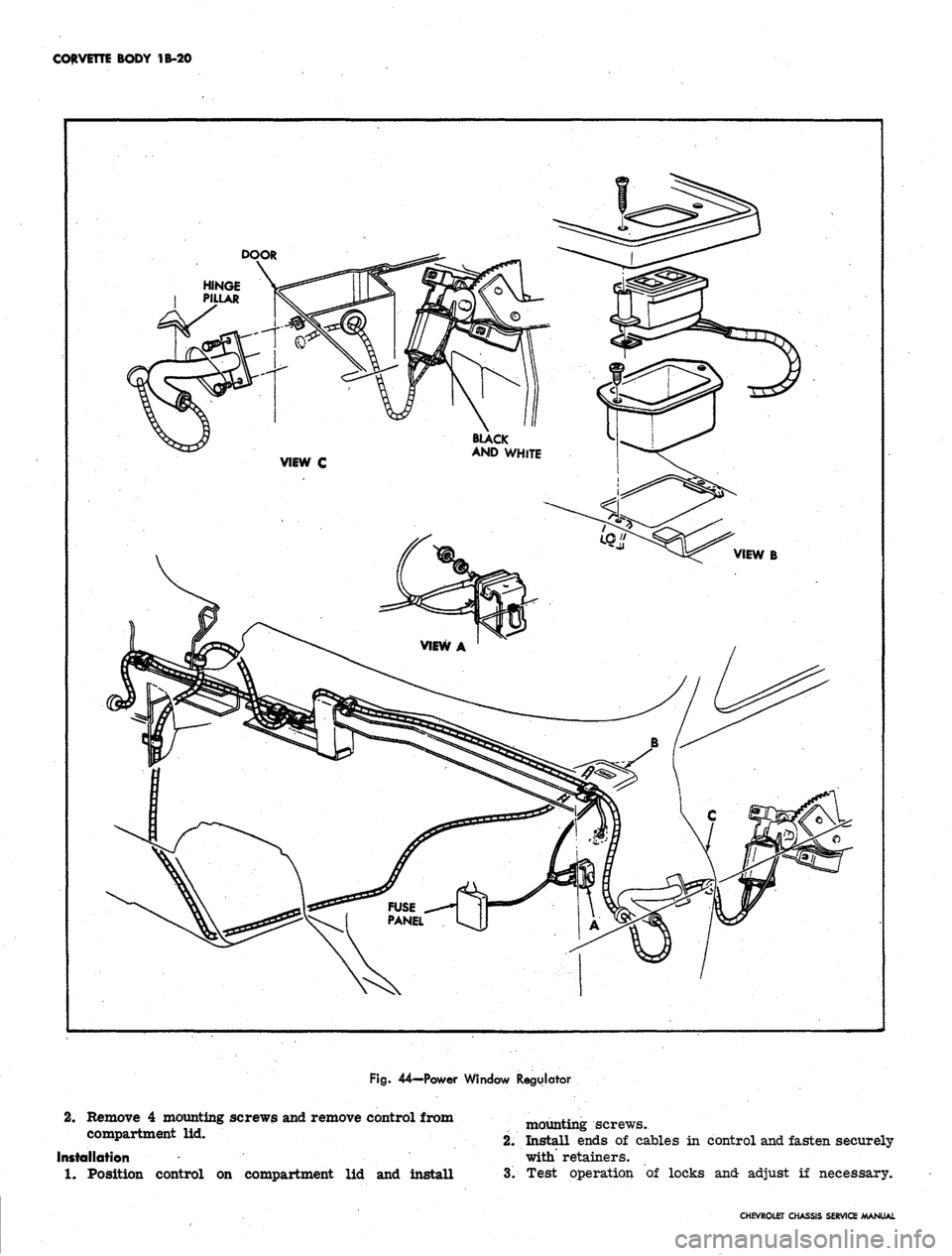
CORVETTE BODY
1B-20
DOOR
Fig.
44—Power Window Regulator
2.
Remove
4
mounting screws and remove control from
compartment
lid.
Installation
*
1.
Position control
on
compartment
lid and
install
mounting screws.
2.
Install ends of cables in control and fasten securely
with retainers.
3.
Test operation of locks and adjust if necessary.
CHEVROLET CHASSIS SERVICE MANUAL
Page 128 of 659

CORVETTE BODY 1B-21
Fig.
45—
Locking Regulator Arm in Place
REAR WINDOW-ADHESIVE CAULKED-
19437 MODEL
For parts identification refer to Figure 55.
1.
Remove the 2 rear window garnish moldings by re-
moving the 14 attaching screws.
2.
Pry molding caps from reveal moldings.
3.
Carefully remove lower, side, and top reveal mold-
ings after marking their position on body with tape.
4.
Secure one end of steel music wire to piece of wood
for handle. Insert other end through caulking mater-
ial at lower corner of rear window; then secure end
of wire to another piece of wood (fig. 56).
5. With the aid of helper, carefully cut through caulking
material (using a sawing motion) with the steel wire;
up side of window, across top, down opposite side,
and across bottom of window.
6. Remove old glass from window opening.
7. Using a sharp scraper or wood chisel, remove ad-
hesive caulking material from body pinchweld flange.
NOTE:
It is not necessary to clean off all the
old caulking material completely from body
opening; however, there should not be any loose
pieces of caulking material left in the opening.
8. Check all reveal molding retaining clips for damage
(24 required). Replace those that are bent or dis-
torted with clips provided in kit.
9. Using weatherstrip adhesive, cement rubber spacers
at bottom, sides, and top of window opening. The
step-type spacers are used at bottom and sides, the
flat type are used at the top, sides, and bottom of
window opening as shown on Figure 55.
10.
Using suction cup holders, position replacement
glass in body opening. Carefully check relationship
of glass to body pinchweld completely around open-
ing. The overlap of glass to body pinchweld and re-
taining flanges should be equal with a minimum over-
lap of 3/16M. Where necessary, position shims under
the lower spacers to obtain required overlap of glass
to body upper and lower flanges.
11.
After proper glass to pinchweld relationship has
been attained, mark position with grease pencil on
glass and body as shown in Figure 57.
12.
Remove glass from body opening and place on pro-
tected surface.
13.
Clean inside edge surface of glass so that glass is
free of any foreign material (oil, grease, etc.).
Using 3/4" masking tape, place tape approximately
1/2 inch from edge of inside surface of glass com-
pletely around glass. Then apply a film of silane
primer to inside edge surface completely around
glass,
also apply silane primer to sealing surface
of pinchweld as shown in Figure 58.
Fig.
46—Door Lock and Remote Controls
1.
Door Lock Remote Control
Assembly
2.
Door Lock Remote Control Knob
3. Door Lock Remote Control Rod
4.
Remote Control Locking Rod
5. Remote Locking Control
Assembly
6. Lock Assembly
CHEVROLET CHASSIS SERVICE MANUAL
Page 154 of 659
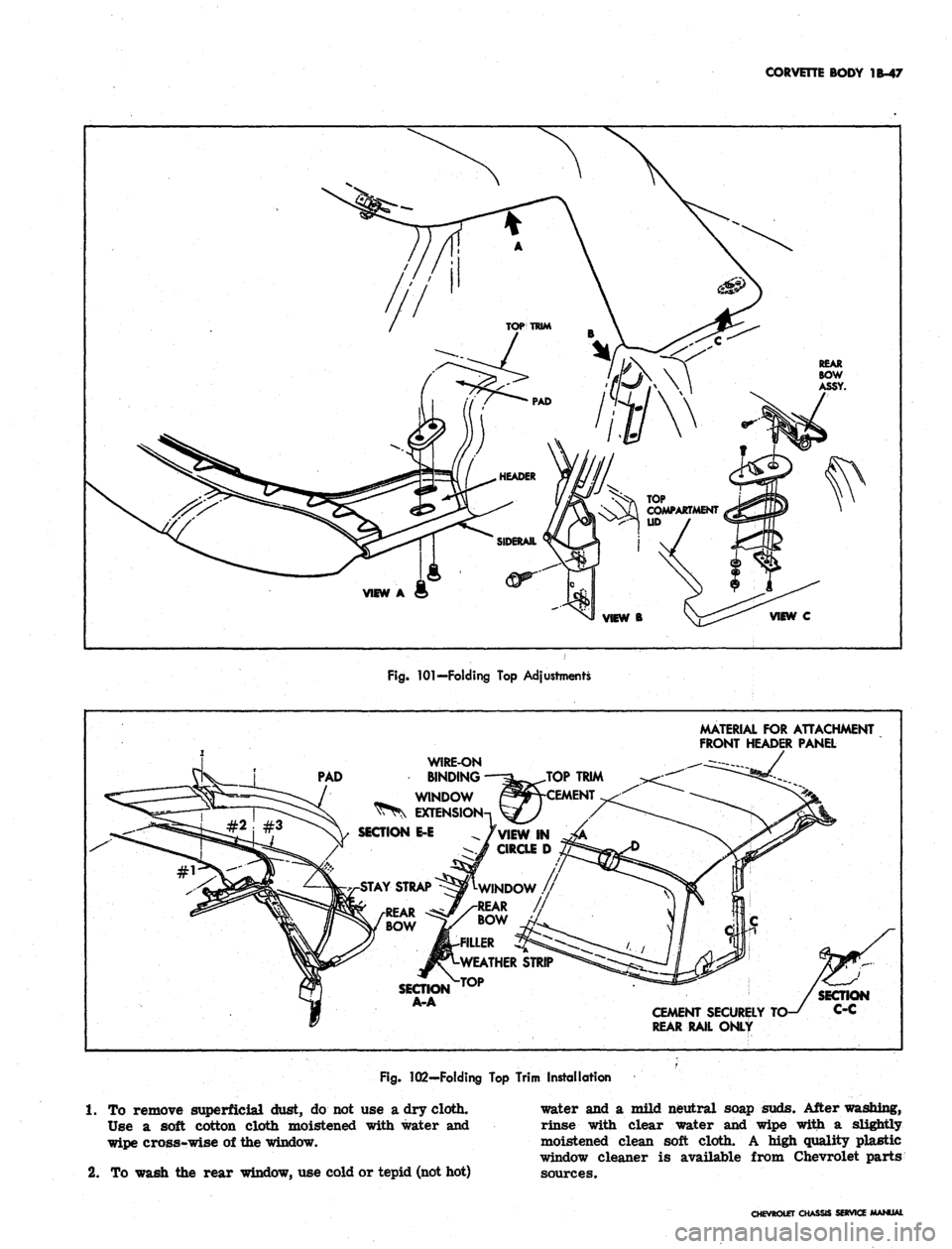
CORVETTE BODY
1B-47
REAR
BOW
ASSY.
VIEW
C
Fig.
101—Folding
Top
Adjustments
MATERIAL
FOR
ATTACHMENT
FRONT HEADER PANEL
PAD
WIRE-ON
BINDING
WINDOW
EXTENS
SECTION
E-E
AY STRAP
SECTION
A-A
CEMENT SECURELY
REAR RAIL ONLY
Fig.
102—Folding
Top
Trim Installation
1.
To
remove superficial dust,
do not use a
dry cloth.
Use
a
soft cotton cloth moistened with water
and
wipe cross-wise
of
the window.
2.
To
wash
the
rear window,
use
cold or tepid (not hot)
water
and a
mild neutral soap suds. After washing,
rinse with clear water
and
wipe with
a
slightly
moistened clean soft cloth.
A
high quality plastic
window cleaner
is
available from Chevrolet parts
sources.
CHEVROLET
Oi
SERVia
Page 158 of 659
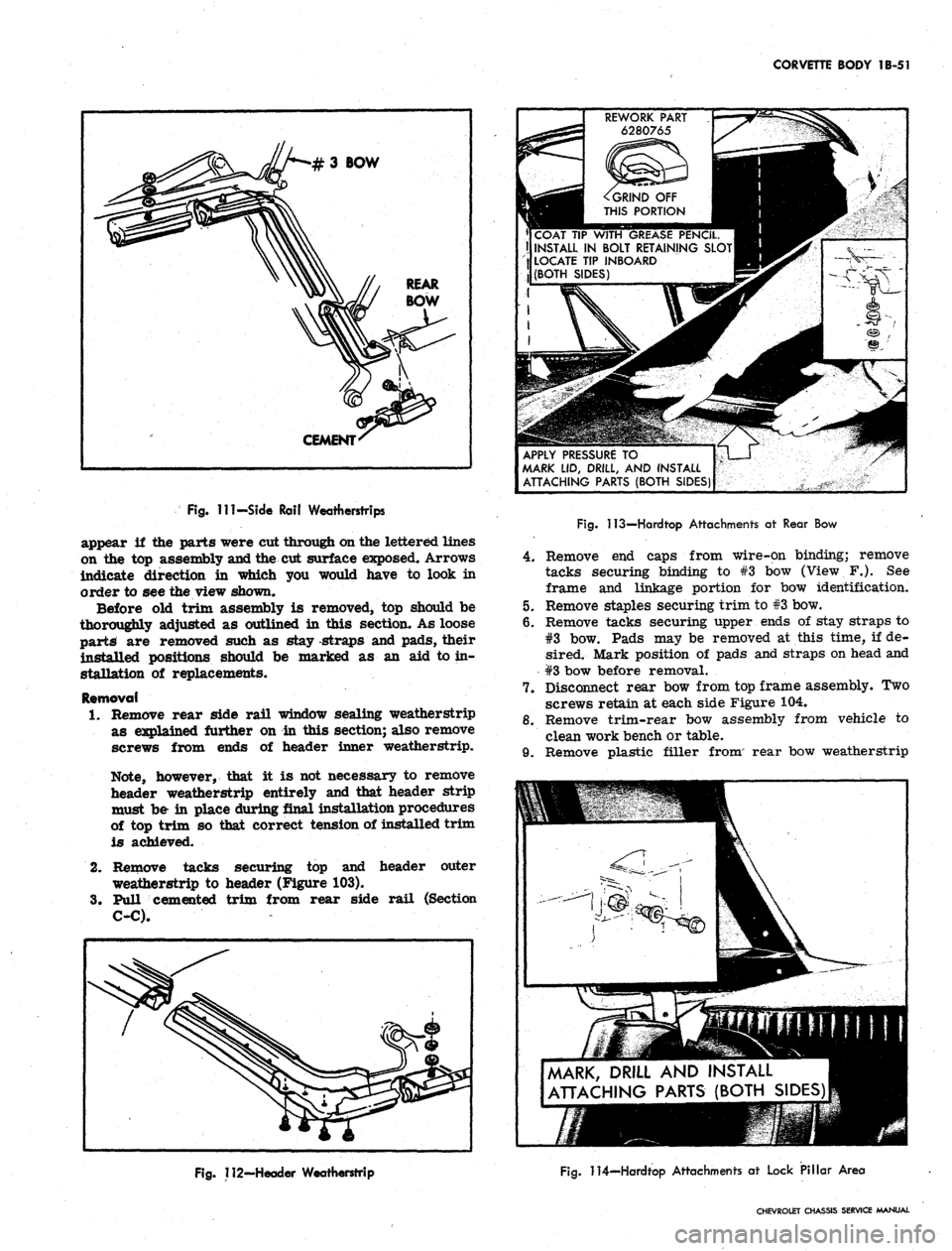
CORVETTE BODY
1B-51
Fig.
Ill-Side Rail Weatherstrips
appear
if the
parts were cut through on the lettered lines
on
the top
assembly and the
cut
surface exposed. Arrows
indicate direction
in
which
you
would have
to
look
in
order
to see
the view shown.
Before
old
trim assembly
is
removed,
top
should
be
thoroughly adjusted
as
outlined
in
this section.
As
loose
parts
are
removed such
as
stay -straps
and
pads, their
installed positions should
be
marked
as an aid to in-
stallation
of
replacements.
Removal
1.
Remove rear side rail window sealing weatherstrip
as explained further
on in
this section; also remove
screws from ends
of
header inner weatherstrip.
Note, however, that
it is not
necessary
to
remove
header weatherstrip entirely
and
that header strip
must
be- in
place during final installation procedures
of
top
trim
so
that correct tension
of
installed trim
is achieved.
2.
Remove tacks securing
top and
header outer
weatherstrip
to
header (Figure
103).
3.
Pull cemented trim from rear side rail (Section
C-C).
REWORK PART
6280765
^GRIND
OFF
THIS PORTION
COAT
TIP
WITH GREASE PENCIL.
II INSTALL
IN
BOLT RETAINING SLOT
LOCATE
TIP
INBOARD
(BOTH SIDES)
APPLY PRESSURE
TO
MARK
LID,
DRILL,
AND
INSTALL
ATTACHING PARTS (BOTH SIDES)
Fig.
113—Hardtop Attachments
at
Rear
Bow
4.
Remove end caps from wire-on binding; remove
tacks securing binding to #3 bow (View F.). See
frame and linkage portion for bow identification.
5.
Remove staples securing trim to #3 bow.
6. Remove tacks securing upper ends of stay straps to
#3 bow. Pads may be removed at this time, if de-
sired. Mark position of pads and straps on head and
#3 bow before removal.
7.
Disconnect rear bow from top frame assembly. Two
screws retain at each side Figure 104.
8. Remove trim-rear bow assembly from vehicle to
clean work bench or table.
9. Remove plastic filler from' rear bow weatherstrip
MARK, DRILL
AND
INSTALL
ATTACHING PARTS (BOTH SIDES)
Fig.
112-Header Weatherstrip
Fig.
114—Hardtop Attachments
at
Lock Pillar Area
CHEVROLET CHASSIS SERVICE MANUAL
Page 159 of 659
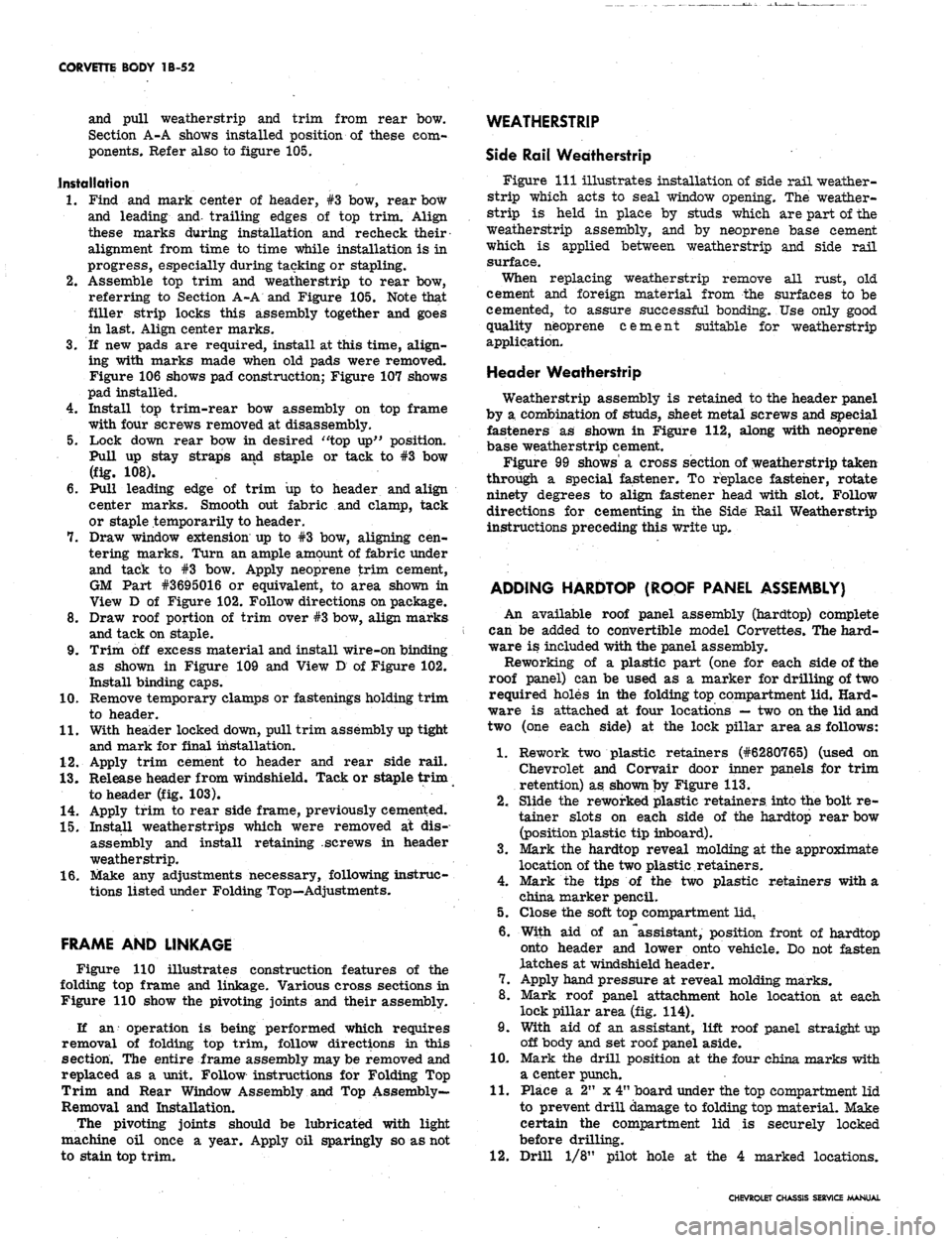
CORVETTE BODY 1B-52
and pull weatherstrip and trim from rear bow.
Section A-A shows installed position of these com-
ponents. Refer also to figure 105.
installation
1.
Find and mark center of header, #3 bow, rear bow
and leading and trailing edges of top trim. Align
these marks during installation and recheck their
alignment from time to time while installation is in
progress, especially during tacking or stapling.
2.
Assemble top trim and weatherstrip to rear bow,
referring to Section A-A and Figure 105. Note that
filler strip locks this assembly together and goes
in last. Align center marks.
3.
If new pads are required, install at this time, align-
ing with marks made when old pads were removed.
Figure 106 shows pad construction; Figure 107 shows
pad installed.
4.
Install top trim-rear bow assembly on top frame
with four screws removed at disassembly.
5.
Lock down rear bow in desired "top up" position.
Pull up stay straps and staple or tack to #3 bow
(fig. 108).
6. Pull leading edge of trim iip to header and align
center marks. Smooth out fabric and clamp, tack
or staple temporarily to header.
7.
Draw window extension up to #3 bow, aligning cen-
tering marks. Turn an ample amount of fabric under
and tack to #3 bow. Apply neoprene trim cement,
GM Part #3695016 or equivalent, to area shown in
View D of Figure 102. Follow directions on package.
8. Draw roof portion of trim over #3 bow, align marks
and tack on staple.
9. Trim off excess material and install wire-on binding
as shown in Figure 109 and View D of Figure 102.
Install binding caps.
10.
Remove temporary clamps or fastenings holding trim
to header.
11.
With header locked down, pull trim assembly up tight
and mark for final installation.
12.
Apply trim cement to header and rear side rail.
13.
Release header from windshield. Tack or staple trim
to header (fig. 103).
14.
Apply trim to rear side frame, previously cemented.
15.
Install weatherstrips which were removed at dis-
assembly and install retaining screws in header
weatherstrip.
16.
Make any adjustments necessary, following instruc-
tions listed under Folding Top—Adjustments.
FRAME AND LINKAGE
Figure 110 illustrates construction features of the
folding top frame and linkage. Various cross sections in
Figure 110 show the pivoting joints and their assembly.
If an operation is being performed which requires
removal of folding top trim, follow directions in this
section. The entire frame assembly may be removed and
replaced as a unit. Follow instructions for Folding Top
Trim and Rear Window Assembly and Top Assembly—
Removal and Installation.
The pivoting joints should be lubricated with light
machine oil once a year. Apply oil sparingly so as not
to stain top trim.
WEATHERSTRIP
Side Rail Weatherstrip
Figure 111 illustrates installation of side rail weather-
strip which acts to seal window opening. The weather-
strip is held in place by studs which are part of the
weatherstrip assembly, and by neoprene base cement
which is applied between weatherstrip and side rail
surface.
When replacing weatherstrip remove all rust, old
cement and foreign material from the surfaces to be
cemented, to assure successful bonding. Use only good
quality neoprene cement suitable for weatherstrip
application.
Header Weatherstrip
Weatherstrip assembly is retained to the header panel
by a combination of studs, sheet metal screws and special
fasteners as shown in Figure 112, along with neoprene
base weatherstrip cement.
Figure 99 shows' a cross section of weatherstrip taken
through a special fastener. To replace fastener, rotate
ninety degrees to align fastener head with slot. Follow
directions for cementing in the Side Rail Weatherstrip
instructions preceding this write up.
ADDING HARDTOP (ROOF PANEL ASSEMBLY)
An available roof panel assembly (hardtop) complete
can be added to convertible model Corvettes. The hard-
ware is included with the panel assembly.
Reworking of a plastic part (one for each side of the
roof panel) can be used as a marker for drilling of two
required holes in the folding top compartment lid* Hard-
ware is attached at four locations — two on the lid and
two (one each side) at the lock pillar area as follows:
1.
Rework two plastic retainers (#6280765) (used on
Chevrolet and Corvair door inner panels for trim
retention) as shown by Figure 113.
2.
Slide the reworked plastic retainers into the bolt re-
tainer slots on each side of the hardtop rear bow
(position plastic tip inboard).
3.
Mark the hardtop reveal molding at the approximate
location of the two plastic retainers,
4.
Mark the tips of the two plastic retainers with a
china marker pencil.
5.
Close the soft top compartment lid.
6. With aid of an ^assistant, position front of hardtop
onto header and lower onto vehicle. Do not fasten
latches at windshield header.
7.
Apply hand pressure at reveal molding marks.
8. Mark roof panel attachment hole location at each
lock pillar area (fig. 114).
9. With aid of an assistant, lift roof panel straight up
off body and set roof panel aside.
10.
Mark the drill position at the four china marks with
a center punch.
11.
Place a 2" x 4" board under the top compartment lid
to prevent drill damage to folding top material. Make
certain the compartment lid is securely locked
before drilling.
12.
Drill 1/8" pilot hole at the 4 marked locations.
CHEVROLET CHASSIS SERVICE MANUAL
Page 173 of 659
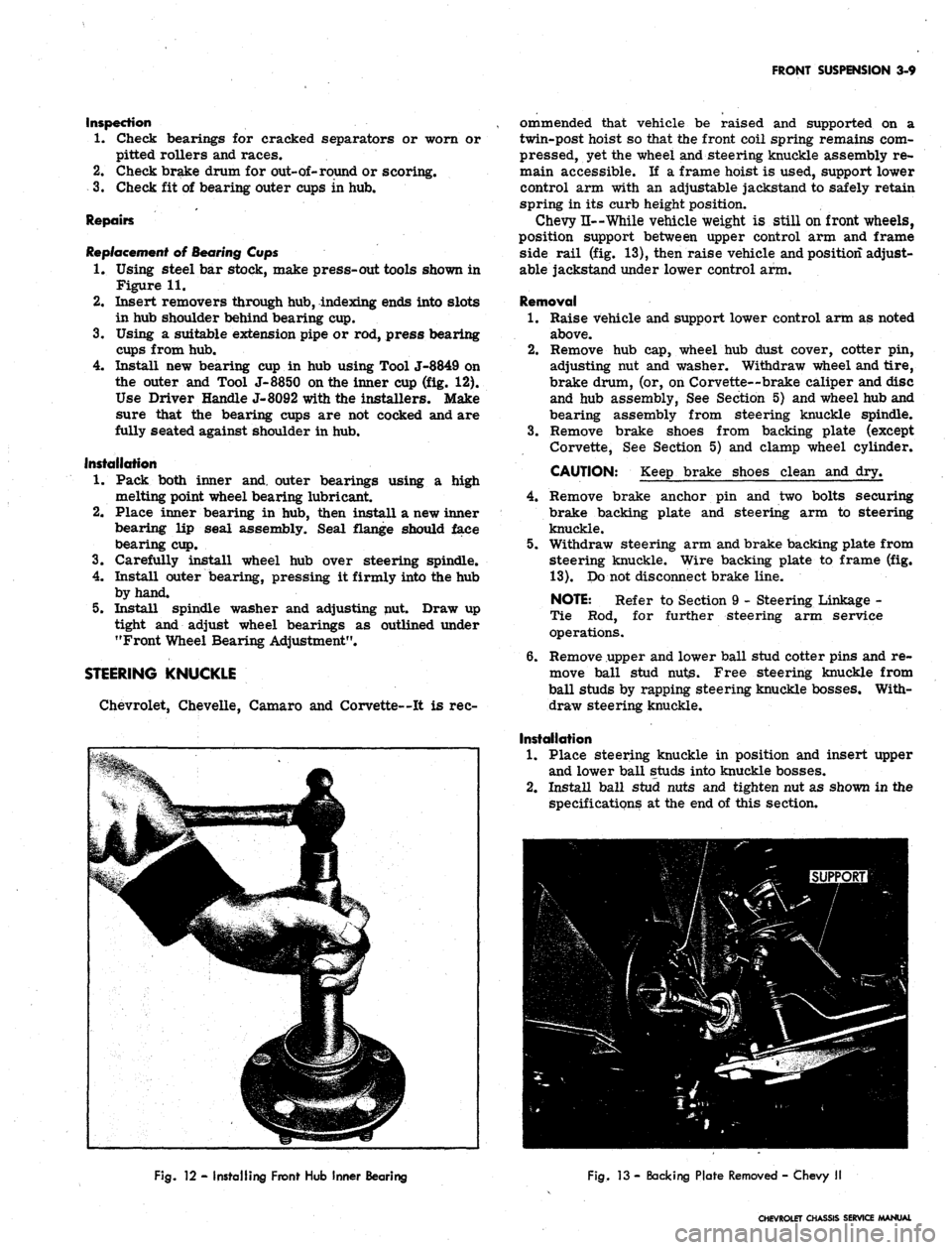
FRONT SUSPENSION 3-9
Inspection
1.
Check bearings for cracked separators or worn or
pitted rollers and races.
2.
Check brake drum for
out-of-
round or scoring.
3.
Check fit of bearing outer cups in hub.
Repairs
Replacement of Bearing Cups
1.
Using steel bar stock, make press-out tools shown in
Figure 11.
2.
Insert removers through hub, indexing ends into slots
in hub shoulder behind bearing cup.
3.
Using a suitable extension pipe or rod, press bearing
cups from hub.
4.
Install new bearing cup in hub using Tool J-8849 on
the outer and Tool J-8850 on the inner cup (fig. 12).
Use Driver Handle J-8092 with the installers. Make
sure that the bearing cups are not cocked and are
fully seated against shoulder in hub.
Installation
1.
Pack both inner and. outer bearings using a high
melting point wheel bearing lubricant.
2.
Place inner bearing in hub, then install a new inner
bearing lip seal assembly. Seal flange should face
bearing cup.
3.
Carefully install wheel hub over steering spindle.
4.
Install outer bearing, pressing it firmly into the hub
by hand.
5.
Install spindle washer and adjusting nut. Draw up
tight and adjust wheel bearings as outlined under
"Front Wheel Bearing Adjustment".
STEERING KNUCKLE
Chevrolet, Chevelle, Camaro and Corvette—It is rec-
ommended that vehicle be raised and supported on a
twin-post hoist so that the front coil spring remains com-
pressed, yet the wheel and steering knuckle assembly re-
main accessible. If a frame hoist is used, support lower
control arm with an adjustable jackstand to safely retain
spring in its curb height position.
Chevy n— While vehicle weight is still on front wheels,
position support between upper control arm and frame
side rail (fig. 13), then raise vehicle and position adjust-
able jackstand under lower control arm.
Removal
1.
Raise vehicle and support lower control arm as noted
above.
2.
Remove hub cap, wheel hub dust cover, cotter pin,
adjusting nut and washer. Withdraw wheel and tire,
brake drum, (or, on Corvette--brake caliper and disc
and hub assembly, See Section 5) and wheel hub and
bearing assembly from steering knuckle spindle.
3.
Remove brake shoes from backing plate (except
Corvette, See Section 5) and clamp wheel cylinder.
CAUTION: Keep brake shoes clean and dry.
4.
Remove brake anchor pin and two bolts securing
brake backing plate and steering arm to steering
knuckle.
5.
Withdraw steering arm and brake backing plate from
steering knuckle. Wire backing plate to frame (fig.
13).
Do not disconnect brake line.
NOTE: Refer to Section 9 - Steering Linkage -
Tie Rod, for further steering arm service
operations.
6. Remove upper and lower ball stud cotter pins and re-
move ball stud nuts. Free steering knuckle from
ball studs by rapping steering knuckle bosses. With-
draw steering knuckle.
Installation
1.
Place steering knuckle in position and insert upper
and lower ball studs into knuckle bosses.
2.
Install ball stud nuts and tighten nut as shown in the
specifications at the end of this section.
Fig.
12 - Installing Front Hub Inner Bearing
Fig.
13 - Backing Plate Removed - Chevy II
CHEVROLET CHASSIS SERVICE MANUAL